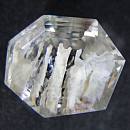|
|
||||||||||||||||
|
||||||||||||||||
|
||||||
|
|
|
|
Kaolinite
(inclusions
in Quartz) |
|
| | |
| Discovered in ancient times; IMA status: Valid (pre-IMA; Grandfathered) | ||
|
| ||
|
Chemistry |
|
|
| |
|
Al2Si2O5(OH)4 | |
|
|
Aluminum Silicate Hydroxide |
|
Molecular Weight: |
258.16 gm |
|
Composition: |
Aluminium |
20.90 % |
Al |
39.50 % |
Al2O3 |
|
|
Silicon |
21.76 % |
Si |
46.55 % |
SiO2 |
|
|
Hydrogen |
1.56 % |
H |
13.96 % |
H2O |
|
|
Oxygen |
55.78 % |
O |
|
|
|
|
|
100.00 % |
|
100.00 % |
= TOTAL OXIDE |
|
|
|
||||
|
Classification |
|
|
| |
|
Silicates (Germanates) | |
|
8/H.25-10 | |
|
|
9 : SILICATES (Germanates)
|
|
Related to: |
Kaolinite-Serpentine Group. Dickite, Halloysite and Nacrite are polymorphs. Chemically identical to Halloysite-7Å. |
|
Members of Group: |
Kaolinite-Serpentine Group: Amesite, Antigorite, Baumite, Berthierine, Brindleyite, Caryopilite, Chrysotile, Clinochrysotile, Cronstedtite, Dickite, Fraipontite, Greenalite, Halloysite, Kaolinite, Kellyite, Lizardite, Manandonite, Nacrite, Népouite, Odinite, Orthochrysotile, Parachrysotile, Pecoraite, Webskyite |
|
Varieties: |
Chrome-Kaolinite, Keramite (of Hunt), Parakaolinite |
|
Synonyms: |
Ancudite, Carnat, China Clay, Clayite (of Mellor), Cleîte, Collyrinum, Collyrum, Creniadite, Fireclay, Kaolin, Leucargilla, Marga Porcellana, Myelin, Neokaolin, Pholerite, Porcelain Clay, Porcelain Earth |
|
|
|
|
Crystal Data |
|
|
|
|
|
Rarely as crystals, thin platy or stacked, to 2 mm. More commonly as microscopic pseudohexagonal plates and clusters of plates, aggregated into compact, claylike masses. |
|
|
None |
|
|
|
|
|
Physical Properties |
|
|
|
|
|
Perfect on {001} |
|
|
Irregular/Uneven, conchoidal, sub-conchoidal, micaceous |
|
|
Sectile, flexible but inelastic |
|
|
2.0 - 2.5 |
|
|
2.61 - 2.68 (g/cm3) |
|
|
None |
|
|
Not Radioactive |
|
|
|
|
|
Optical Properties |
|
|
|
|
|
White to tan or cream and pale-yellow; also often stained various hues of tans and browns by impurities |
|
|
Transparent to opaque, translucent as single crystals |
|
|
Waxy, pearly to dull, earthy |
|
|
1.553 - 1.570 Biaxial ( - ) |
|
|
0.007 - 0.017 |
|
|
Weak; r > v |
|
|
None |
|
|
|
|
|
Occurances |
|
|
|
|
|
Geological Setting: |
Replaces other aluminosilicate minerals during hydrothermal alteration and weathering. A common constituent of the clay-size fraction of sediments, where it may be formed by direct precipitation. |
|
Common Associations: |
Quartz, Feldspar, Muscovite |
|
Common Impurities: |
Fe, Mg, Na, K, Ti, Ca, H2O |
|
Type Locality: |
Gaoling Mine (Kaoling Mine), Gaoling village, Ehu town, Fuliang County, Jingdezhen Prefecture, Jiangxi Province, China |
|
Year Discovered: |
Ancient times. Known since the Yuan (Mongol) dynasty in the thirteenth century. Named in 1637 |
|
View mineral photos: | |
|
|
|
|
Unusual Gem Categories |
|
|
|
|
|
| |
|
|
|
|
More Information |
|
|
|
|
|
| |
|
|
|
|
Kaolinite was first properly described and named in 1637 by Chinese scientist and encyclopedist Song Yingxing (1587-1666) who lived during the late Ming Dynasty. Kaolinite was named for the ancient Chinese type locality at the "Kao-Ling" Mine (from Gaoling, meaning high ridge), Jingdezhen Prefecture, Jiangxi Province, China. Kaolinite was possibly the most important mineral in clays used in pre-historic pottery. Kaolinite was introduced to the West by a French priest in 1712. Kaolinite is largely found in masses, in clay beds, usually with a bright white color. Kaolinite is too soft to be used as a gem on its own, but it is available as inclusions in Quartz gems. The picture above shows a faceted Quartz gem with beautiful inclusions of white Kaolinite. If you place your cursor over the picture you will see a magnified picture of white Kaolinite formations in the Quartz. This gem is from a recent find in Madagascar. Kaolinite
distribution: pure
material from many localities, including: at Kauling,
Kiangsi Province, China. In numerous china-clay pits
in Cornwall and Devon, England. At Limoges, Haute-Vienne,
France. Near Dresden, Kemmlitz, and Zettlitz, Saxony,
and elsewhere in Germany. Large deposits in the Donets
Basin, Ukraine. In the USA, at Macon, Bibb County, Georgia;
at the Dixie Clay Company mine, and in the Lamar Pit,
near Bath, Aikin County, South Carolina; near Webster,
Jackson County, North Carolina; near Murfreesboro, Pike
County, and at Greenwood, Sebastian County, Arkansas;
from Mesa Alta, Rio Arriba County, New Mexico. At Huberdeau,
Quebec, and near Walton, Nova Scotia, Canada. |
|
|
We
have not photographed our Kaolinite
gems yet. Please
check back soon. |
